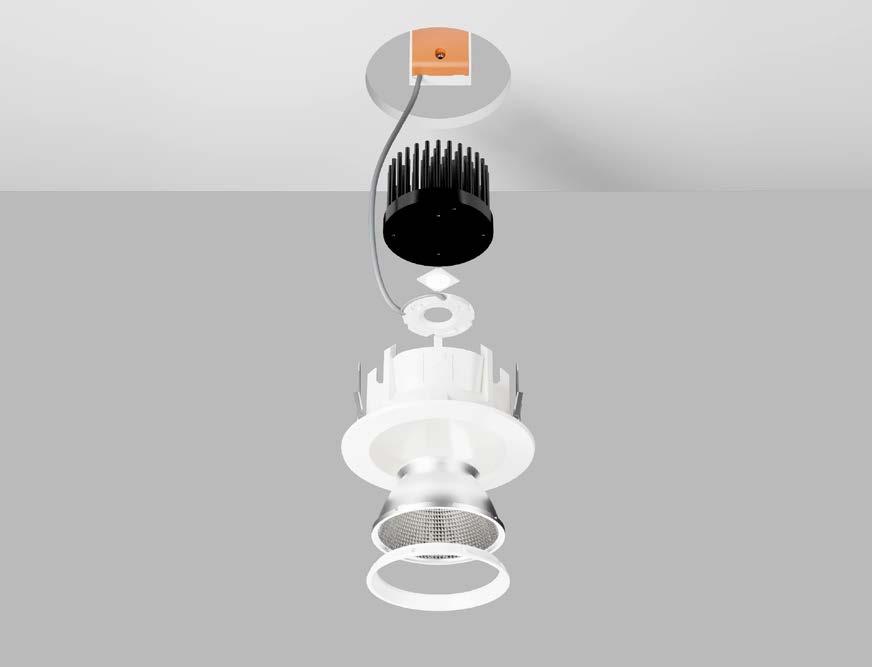
4 minute read
3D Goes Mainstream

3D printed luminaires represent a revolutionary intersection of technology and design, transforming the way we perceive and interact with lighting fittings. The advent of 3D printing technology has empowered designers to create intricate and customised luminaires that not only illuminate spaces but also serve as unique pieces of art.
One of the key advantages of 3D printing in luminaire production is the unparalleled flexibility it offers in terms of design. Traditional manufacturing methods often impose limitations on intricate and complex designs, but 3D printing allows for the creation of highly detailed and intricate structures that were once deemed impossible.
This capability enables designers to experiment with innovative shapes, patterns, and textures, resulting in luminaires that push the boundaries of conventional aesthetics.
Crucially, 3D printed luminaires often showcase enhanced sustainability. The additive manufacturing process used in 3D printing minimises material waste and the ability to use eco-friendly and recycled materials further contributes to their sustainability.
It’s fair to say that Signify has been a real pioneer in this area in terms of scale.
It has supplied major clients such as UK retail giant Marks & Spencer and more recently, the company has introduced a range of pendants manufactured from what the company terms ‘bio-circular materials’.
At least 55 percent of the Essential series is made from materials derived from waste and residues of biological origin from agriculture, forestry and related industries, such as tall oil from the wood processing industry and used cooking oil.
Signify stresses that the materials are thus not made from crude oil but from natural sources.
It says that the entire supply chain from the granulate supplier to the filament and luminaire production is certified by the International Sustainability and Carbon Certification, an independent certification system supporting climate-friendly supply chains.
The Essential range – 3D printed at Signify’s factory in Turnhout, Belgium – is available in three sizes and can be mounted in three different ways.
Signify 3D printing facilities are also operational in the United States of America in Burlington, Massachusetts, serving both professional and consumer markets.

Shoplight’s Colt Bio is a recessed fixed downlight made from sustainable bioplastic.
Also going down the bioplastic route is UK retail lighting specialist Shoplight. Its Colt Bio is a recessed fixed downlight made from sustainable bioplastic. The housing is made from Greentech Pro, a material with excellent flexural strength and little warping, as well as a high-quality surface. It’s food-safe and biodegradable to DIN EN ISO 14855.
Digital printing means the outer bezel on the downlight can be manufactured to any size up to 300mm diameter, making it suitable for replacing existing, larger downlights.
It’s also made from recycled, recyclable and biodegradable materials, is designed to remain in use
and, when it does reach end of life, can be handed back to Shoplight under its buy back scheme, when it can then be reconditioned.

Another UK firm, start-up LumiAdd, is focusing on printing with biodegradable plastic. The Origin series of pendants is made from polyhydroxyalkanoate, or PHA, a bioplastic that ‘fades back into nature’.
PHA is created by a naturally occurring process called fermentation. It's 100 percent bio-based and biodegradable and results in no microplastics.
The company says the material is particularly good for translucency. PHA in white gives a ‘beautiful warm glow’ when lit whereas PHA natural is more translucent and has a ‘warm pearl-like’ finish.

Luminaire components can be manufactured in the same location where final assembly is completed, greatly reducing transport related carbon emissions.
With the manufacturing process of 3D printing, there is no requirement for hard tooling, eliminating the need for stock holding and subsequently reduces any potential waste through product obsolescence and product evolutions.
It future proofs product maintenance and remanufacture, as replacement parts can be produced in required volumes with no time constraints.
Any design evolution can be easily integrated without the need for lengthy and costly tooling modifications.
The luminaires are designed to be re-used, repaired and re-manufactured, with recycling or industrial composting being the last option. ■










